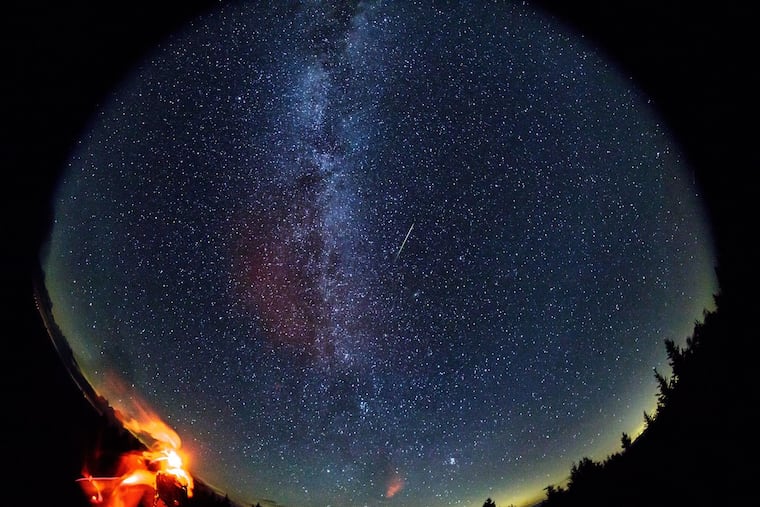Perseid meteor shower is peaking, and the moon is getting out of the way
Expect up to 80 meteors an hour if you find a dark, open space. The show will peak early Wednesday, Thursday, and Friday.

With the skies expected to be partly cloudyand the moon graciously unobtrusive, the early morning hours of Friday could be a decent time for viewing the annual Perseid meteor showers.
And while Friday would mark the end of the peak period, the Perseids will persist well into next week.
Under dark-sky conditions, as many as 80 meteors an hour — with a potential for more — should be visible early Friday, said Bill Cooke, head of NASA’s Meteoroid Environment Office and who quite literally is a meteor-ologist who can confidently forecast a 100% chance of a meteor shower.
The 2021 version of the Perseids has been streaking across the sky since late July, but their numbers have been gradually increasing and are due to peak during the early morning hours of Wednesday, Thursday, and Friday.
What are these things?
Annually, the Earth’s orbit intercepts the leftover debris of the comet Swift-Tuttle, named for Lewis Swift and Horace Tuttle and which was once viewed as a menace to planet Earth.
It visits our solar system every 133 years and doesn’t clean up after itself. As the fragments enter our atmosphere, 50 to 75 miles up, they speed toward Earth at about 130,000 mph, NASA estimates; think of getting from Philadelphia to Atlantic City in less than two seconds.
They become incandescent as they fall through the atmosphere and appear as streaks in the sky, and occasionally the bigger fragments explode into greenish fireballs.
But most of the streaks are set off by particles whose size ranges from a sand grain to a small pebble, the International Meteor Organization estimates.
Swift-Tuttle last freshened its trail in our solar system in 1992, and it created quite a cosmic dustup. It has a 16-mile nucleus, NASA says, or twice the size of the space projectile hypothesized to have wiped out the dinosaurs.
A British astronomer, now deceased, had predicted that Swift-Tuttle would smash into Earth on the next go-round in August 2125.
However, before you change your vacation plans, Cooke says that is not going to happen. So, we should be able to enjoy the Perseids in peace at least until 2258.
Where and when to look
You’ll want to find the widest, darkest skies possible, which can be a challenge around here, given all the light interference.
This is not Arizona, but recommendations among local astronomers include the area around Lake Nockamixon, in Bucks County; French Creek Park, which straddles Chester and Berks Counties; and Wharton State Forest in New Jersey.
» READ MORE: Stargazing around Philadelphia: Everything you need to know
It would be wise to spend a half-hour or so adjusting to the darkness, the Earthsky astronomy site advises.
These are called the Perseids — the second most prolific showers of the year after the Geminids, in December — because they appear to radiate from the constellation Perseus, which is about 240 light years from here, but they will flash all over the sky.
The best viewing times would be between 12:01 a.m. and daybreak. And you don’t need binoculars or a telescope.
The best way to avoid a stiff neck is to watch from a reclining lawn chair or blanket.
Actually, the surest way to avoid a stiff neck is to watch on Youtube, courtesy of NASA, which will be broadcasting the meteor show for seven-hour segments starting at 11 p.m. Philadelphia time Wednesday, Thursday, and Friday. It also will be posting during those hours on Facebook and Twitter.
Meteor-ology
The term “meteorology,” which of course applies to weather, is a hangover from one of Aristotle’s musings, but Cooke is an actual meteor-ologist who forecasts meteor behavior, which is critical to NASA’s missions.
His science does have limits. He can say with certainty that the Perseids will appear in the skies, but not how many.
While the Swift-Tuttle debris mass is a little less than usual this year — which is why he says the peak is likely to be 80 an hour rather than the standard 100 — meteor showers can spring surprises. In 1993, he said, 300 an hour appeared during the peak period.
The intensity of the showers can be influenced by the gravity of neighboring planets, particularly the giant Jupiter, “the gravitational bully of the solar system,” he said.
But the meteor show will appear like clockwork, of that we can be sure. “I can be very precise on the timing because that’s based on celestial mechanics,” he said.
During the Leonid showers in November of 1999 and 2002, he warned his employers that the showers posed a threat to astronauts at the International Space Station. NASA didn’t doubt him, he said. “The astronauts weren’t allowed out.”